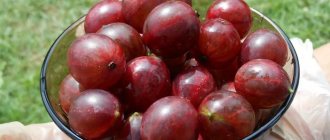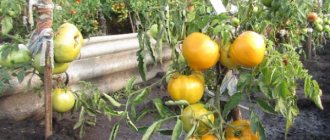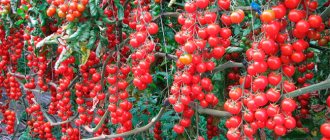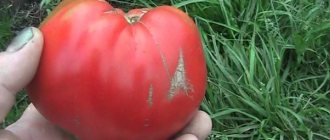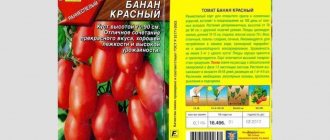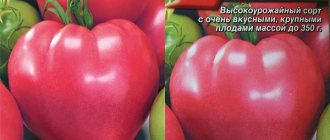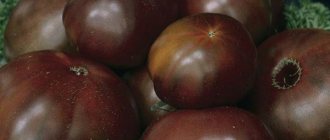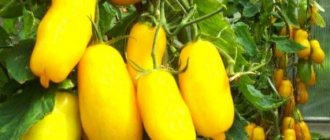Description of the variety and characteristics of tomatoes Nastena F1
The originator of tomatoes of the Nastena F1 variety was the research and production plant. In 2005, the company applied to include the hybrid in the state register. After testing, the variety received a positive assessment and was zoned for the Central Black Earth region.
Tomato Nastena F1 is recommended to be grown in the middle zone. Plants develop well in open ground. At the same time, the hybrid can withstand cool climates and high humidity. In such conditions, it is planted in a greenhouse or greenhouse.
Tomato variety Nastena F1 determinate. When fruit formation begins, its growth stops. The height of the bush depends on the growing method. Under film or glass cover, plants reach 1.3 m. Outdoors, tomatoes grow up to 1 m.
The bushes are powerful, their central stem is strong. The leaves of the plant are green and medium in size. Inflorescences are of a simple type. The peduncle has an articulation. Plants are weakly leafy. Due to this, the fruits receive more sunlight, have a good taste and bright color. Good ventilation of the bush also reduces the risk of the spread of diseases and pests.
Characteristics of the fruits of the Nastena F1 variety:
- flat-round shape;
- mild ribbing;
- The color of unripe tomatoes is light green;
- when ripe, the skin turns red;
- number of nests from 4 to 6;
- The weight of the fruit is 95 - 145 g.
Crop ripening begins early. Tomatoes are collected in brushes of 5-7 pieces. The fruits of the Nastena variety are approximately the same size. The pulp is dense, juicy and meaty. The largest specimens reach 300 g.
Features of care
Two weeks after planting the seedlings, they will need to be watered abundantly. Then the same procedures will need to be carried out during the flowering of the tomato and during the period of formation and ripening. One bush will need at least three liters of water. After each watering, the soil should be loosened.
In order for the fruits to be large, fertilizers must be applied during flowering, fruit formation and ripening. Mineral and organic fertilizers are suitable.
When growing in a greenhouse, gardeners have additional concerns:
- the greenhouse must be ventilated in a timely manner;
- it is necessary to monitor temperature and humidity conditions;
- remove weeds regularly.
In order for the fruits to receive as much sunlight as possible, it is recommended to remove the leaves under each flower ovary. You can remove no more than three leaves from one bush per week.
Tomato variety Nastenka: what is the difference
Nasten tomatoes are often confused with another variety that has a similar name - Nastenka. However, these are different hybrids, each of which has its own characteristics.
Attention! The main differences between the Nastenka and Nastena varieties are the size of the bush, color, taste and shape of the fruit.
According to reviews, the Nastenka tomato variety has a good taste. Its use is universal: fresh consumption and canning. The hybrid is suitable for planting in any region of Russia.
The Nastenka variety ripens in the middle period, later than the Nastena tomatoes. The plant is of a determinate type, grows up to 70 cm in height. The bush is compact and takes up little space in the garden bed. Such tomatoes do not need shaping.
Nastenka variety tomatoes in the photo:
The fruits of the Nastenka variety are round and elongated. Their shape is heart-shaped. The color is pink, the flesh is fleshy. The average weight of the fruit is 130 g, the largest specimens reach 500 g.
Advantages and disadvantages
As you understand, the hybrid is quite good, and so that you can accurately decide on your choice, we will once again mention point by point what you should pay attention to.
Advantages of Nastena tomatoes:
- productive tomato - according to reviews, it can produce, with good care, up to 18 kg per square meter;
- saves time - there is no need to pinpoint, shape, thin out bushes, supports - as desired;
- does not get sick and is not afraid of insects;
- the fruits are very tasty and suitable for both canning and eating fresh;
- can be stored for a long time and transported well;
- has good resistance to low temperatures.
But does this wonderful hybrid have any negative sides? If you can call it that, that is.
- any hybrid variety does not produce a good harvest in the second year, so there is no point in collecting seeds;
- demanding on the amount of fertilizing, but you can use conventional complex preparations throughout the entire growing season;
So, as you can see, a decent tomato. If you are interested in it, then we advise you to also get acquainted with the method of growing it; it is quite simple, but still everyone should study it.
Agricultural technology tomato Nastena
When growing Nastena F1 tomatoes, various factors are taken into account: the quality of the soil, the illumination of the area, the supply of moisture and nutrients. To increase productivity, it is recommended to use the seedling method. Seeds are planted at home, and grown seedlings are transferred to a permanent place.
Growing seedlings
Seeds of the Nastena F1 variety are planted in March. Boxes or separate containers 12-15 cm high are prepared for seedlings. They are filled with light fertile substrate. It is convenient to use peat tablets for tomatoes. The soil is taken from the site or purchased ready-made soil in the store. In the first case, the soil is kept in the cold for 2 - 3 months or heated in the oven for disinfection.
First, tomato seeds are dipped in a weak solution of potassium permanganate for 20 minutes. Then they are washed with warm water and planting work begins.
Instructions for planting tomato seeds Nastena F1:
- Soil is poured into the container and compacted.
- The seeds are distributed over the surface in increments of 1.5 cm. A distance of about 3.5 cm is maintained between the rows. When using peat cups, 2 - 3 seeds are placed in each cup.
- Soil or peat 1 cm thick is poured on top.
- The substrate is watered through a sieve or spray bottle.
- The containers are covered with film and kept in the dark at a temperature of 25 °C.
The first shoots appear in 10-14 days. Plants are moved to the window. Seedlings should receive lighting for 11 - 13 hours. If there is not enough light, turn on the phytolamps. They are placed at a distance of 30 cm from the seedlings.
Seedlings of the Nastena F1 variety are watered every week with warm, settled water. Use a spray bottle with a fine spray. Excess moisture is drained. For feeding, prepare a solution of complex fertilizer Nitrophosk or another. The product is applied at the root of the seedlings no more than 3 times.
When the 2nd leaf appears on the tomatoes, pick them. Plants are transplanted into new, more spacious containers. If Nasten's tomatoes are planted in separate pots or peat cups, then this stage is skipped. The seedlings are carefully removed from the soil, trying not to damage the root system. Then they are transplanted into prepared containers and watered.
3 - 4 weeks before transferring to the ground, Nasten tomatoes are hardened. Open the window in the room for 1 - 2 hours. As the containers with seedlings harden, they are moved to the balcony. This way the plants will be able to stay in natural conditions and will better tolerate planting in the ground.
Landing rules
Nasten tomatoes are planted in a greenhouse and open ground. The beds are prepared in the fall: they are dug up and cleared of the remains of previous crops. Tomatoes require fertile, light soil. Select areas after cabbage, carrots, beets, onions, garlic, and herbs. If any varieties of tomatoes, potatoes or peppers grew in the garden bed, then it is better to find another place for the Nastena variety.
Advice! The seedlings are transferred to a permanent place at the age of 50 - 60 days.
First, they wait until the frosts pass and the soil warms up. Depending on the region, this will be the end of May or the beginning of June. If there is still a possibility of cold weather, then the plantings are covered with non-woven fabric at night.
To transplant tomatoes of the Nastena F1 variety, choose a cloudy day or evening. The soil in the containers is watered and the seedlings are removed. Planting holes up to 40 cm deep are dug in the beds. A substrate of humus and wood ash is poured onto the bottom, then a layer of fertile soil is poured. The hole is watered and the plants are transferred into it.
Tomatoes of the Nastena variety are planted at a distance of 40 cm from each other. Leave 50 cm between the rows. It is more convenient to place the tomatoes in a checkerboard pattern. This ensures good ventilation of the bushes and simplifies the care of the crop.
Watering and fertilizing
According to reviews, Nasten F1 tomatoes respond well to watering and fertilizing. Water is added every 5 - 7 days. The watering rate per bush is 3 - 5 liters. Moisture is especially important for plants when flowering. If the tomatoes do not receive it during this period, this will lead to a decrease in yield.
When the fruits ripen, watering is made less intense. Excess water in the soil leads to cracking of tomatoes. When adding moisture, make sure that the roots of the plants are not exposed.
Important! After watering, it is better to loosen the soil to saturate it with oxygen. As a result, tomatoes will better absorb moisture and nutrients.
Tomatoes are fed every 2 - 3 weeks. Alternate natural and mineral fertilizers. At the beginning of the growing season, mullein infusion is prepared for tomatoes of the Nastena variety. After flowering, superphosphate and potassium salt are added. Universal fertilizer for tomatoes is wood ash and yeast starter.
Pinching and tying
Nasten F1 tomatoes do not require pinching. The growth of the crop bush is limited. When the plant reaches a height of about 1 m, its development stops. Tomatoes are tied to a support. To do this, plastic or metal pipes are driven into the soil. Between them string ropes in 2-3 rows.
Formation
According to reviews and photos, the Nastena F1 tomato has the correct shape. The bush is compact, the number of shoots is limited. Tall tomatoes need shaping. The Nastena variety can be grown without formation.
Features of cultivation and storage
The quality and quantity of the harvest depends on the right location and timely prepared bed. The Nastena variety is so unpretentious that it can be grown by novice gardeners.
Growing seedlings
It is profitable to grow the determinant variety Nastena; it is capable of setting fruit in any conditions. When grown in the south, the seeds are sown directly into the ground; in regions with short summers, Nasten F1 tomatoes, according to gardeners, are better grown through seedlings.
To obtain strong and healthy seedlings, it is necessary to prepare the soil and planting material. Soil for planting seeds can be bought at the store, or you can prepare it at home. To do this, mix peat and sand in a ratio of 3:1.
To prevent an adult plant from getting sick, the seeds must undergo a disinfection stage before sowing. To do this, the seed can be soaked for 10 minutes in a weak solution of potassium permanganate or a warm solution of water and hydrogen peroxide (100 ml of water and 3 ml of peroxide).
For planting, you can use peat or plastic cups, 10 cm high boxes or peat tablets. When planting in boxes and plastic cups, the containers must be scalded with boiling water.
The prepared containers are filled with nutritious soil, the seeds are spilled and buried to 1.5 cm. The crops are covered with polyethylene or glass to create a microclimate favorable for germination and put in a warm place. After the emergence of seedlings, the shelter is removed and the seedlings are transferred to a well-lit place. Since the seeds are sown at the end of March, it is necessary to install additional lighting.
After the appearance of 3 true leaves, the seedlings are planted in separate containers of larger volume, deepening the plant to the cotyledon leaves.
Before transplanting tomatoes to a permanent place, it is necessary to harden them. To do this, the tomatoes are taken out into the open air, for the first time for 5 minutes, then increasing the stay time by 5 minutes daily.
Transplanting seedlings
Seedlings ready for planting should be 30 cm high and have a flower cluster. Before planting, dig up the soil, add humus, wood ash and crushed eggshells.
In the prepared bed, holes are made at a distance of 50 cm from each other. The best predecessors for the Nasten tomato are legumes, cereals and pumpkin crops. After potatoes, peppers and eggplants, tomatoes can be planted after 3 years.
The planting hole is shed generously with settled, warm water. Next, the seedlings are carefully removed from the cup and planted at right angles to the ground. The plant is covered with earth, compacted, watered and mulched. You can use straw, grass clippings or sawdust as mulch. Mulch is an assistant to the gardener, as it:
- retains moisture;
- prevents weeds from germinating;
- nourishes the soil;
- protects the root system from sunburn.
To prevent the plant from being attacked by insect pests, you can plant herbs, calendula and marigolds next to the tomatoes.
Tomato care
Caring for the Nastena tomato variety is simple; it involves watering and fertilizing.
The first watering with warm, settled water is carried out 2 weeks after planting the seedlings. Further, abundant irrigation is necessary:
- during flowering;
- during the period of fruit formation and ripening.
Since tomatoes are a moisture-loving plant, 3 liters of water are poured under each bush. After watering, the soil is loosened and mulched.
Fertilizing is necessary for the Nastena tomato to form large fruits. Fertilizers are applied during flowering, during the formation and ripening of fruits. Complex mineral and organic fertilizers are used as fertilizer.
Tomato variety Nastena greatly simplifies the gardener’s work:
- he does not develop stepchildren;
- it does not need to be formed;
- A garter is necessary only if a large number of fruits are formed on the hand.
Additional care when growing in a greenhouse:
- regular ventilation;
- compliance with temperature and humidity conditions;
- artificial pollination;
- timely removal of weeds;
- disease prevention;
- Regular collection of fruits to increase fruiting.
For better fruit set, greenhouse tomatoes require artificial pollination. To do this, pollinating insects are attracted, frequent ventilation is carried out in windy weather, and the bush is shaken daily.
In order for the plant to receive more light, it is necessary to remove the leaves under each flower ovary. You can cut no more than 3 leaves per week.
The hybrid is intended for planting:
- in greenhouses in regions with temperate climates;
- in open beds in the south;
- in Siberia and the north in protected heated greenhouses.
It is grown traditionally - through seedlings. The bushes are transplanted to permanent plots upon reaching 50-55 days.
The soil is fertilized in advance - organic matter and minerals are added per 1 m2:
- 1 bucket of compost;
- 20-30 g of superphosphate;
- 10 g potassium sulfate.
How to care:
- bushes form into 2 shoots;
- stepchildren 1 time in 10 days;
- water at the root 2 times a week, the water norm is 6-8 l;
- Root and foliar fertilizers are used.
It is necessary to fertilize during flowering, setting and ripening. For nutritional components, use 1:10 diluted litter. Mineral supplements that are used include:
- phosphorus-potassium mixture;
- saltpeter;
- nitrogen compounds;
- boric acid.
Protection from diseases and pests
Nasten F1 tomatoes are resistant to verticillium and other nightshade diseases. Ventilating the greenhouse, weeding, and controlling soil moisture will help protect plants from damage. To combat diseases, the drugs Topaz, Hom, Ridomil are used.
Serious damage to plantings is caused by pests: aphids, thrips, mole crickets, spider mites. Pests are repelled using folk remedies: tobacco dust or wood ash is sprayed, plants are sprayed with infusion of wormwood or onion peels. If there are too many pests, use insecticides Iskra, Fufanon, Fitoverm. The drug is dissolved in water and the tomatoes are treated leaf by leaf.
Another Nastenka
The wide selection of varieties is sometimes misleading with similar names. Summer residents are often confused. For example, along with the Nasten hybrid from the Russian Seeds company, there is the Nastenka variety from.
Authors of Nastenka: M. A. Kotelnikova, S. N. Kondakov. This variety was included in the state register in 2008. It can be grown both in the ground and in any type of greenhouse. The purpose of the fruit is universal. Usage options:
- In raw form.
- In pickling.
- In canning.
The plant is mid-season with a standard, determinate bush that requires staking. The bushes are covered with small leaves, the flowers are collected in simple inflorescences.
Description of fruits
The fruits are multi-chambered (6 chambers) heart-shaped and pink when ripe. The pulp has excellent taste, medium density. The average weight of a tomato is from 120 g. A tomato yield of up to 2 kg is obtained per square meter.
Productivity
Nasten's tomatoes are among the first to bear fruit. The period from the appearance of sprouts to the ripening of tomatoes is 95 - 98 days. The harvest begins in July. Fruiting is extended, lasting until September.
From 1 sq. m of planting, 16 - 18 kg of fruits are harvested. The yield from one bush of the Nastena F1 variety is 5 - 8 kg. When grown on an industrial scale, you can harvest from 176 - 507 c/ha. These are high indicators compared to standard varieties. For example, the famous tomatoes Nepravda and Dar Zavolzhye under similar conditions bring a yield of about 159 - 495 c/ha.
Nasten tomatoes are picked ripe or at the stage of technical maturity. The crop ripens without problems at room temperature. The yield of marketable products ranges from 69 to 90%. Due to the compacted skin, Nastena F1 tomatoes are well transported. The shelf life of the crop at home is up to 45 days.
Characteristic
Nasten tomatoes appeared in the greenhouses of Russian gardeners in 2008. It was then that Russian scientists developed this hybrid. During numerous tests, the new variety showed high yield and unpretentiousness, so they began to grow it literally on an industrial scale. As for the Nastena type, the variety can be classified as determinate, which means that it has growth restrictions. An adult plant is a powerful bush with a small number of leaves; its height rarely exceeds one meter. Due to the fact that there are few leaves on the hybrid, the bush is well ventilated, and each tomato receives a sufficient amount of sunlight.
The Nastena tomato, the photo of which you see above, belongs to the early ripening varieties. From the moment the first shoots appear until harvest, usually no more than 3 months pass. The first flower cluster appears above the sixth leaflet, subsequent ones are formed every two.


